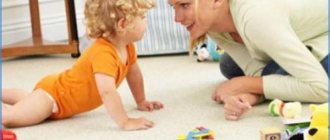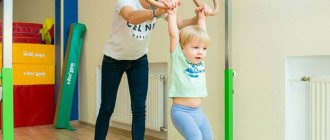When the baby starts to coo and smile
Towards the end of the first month of life, the child begins to make simple vowel sounds in response to some events. This is how speech begins to develop. The same letters, but in different intonations, can speak of both childish admiration and dissatisfaction. The volume of pronunciation for each intonation is also different. As a rule, joy is not accompanied by such a loud “ah” as protest.
The first smile can be noticed after the first month of life. Although the mother can observe an unconscious smile immediately after birth. The fact is that the muscles of children, especially in the first time after childbirth, involuntarily and sharply contract. A child, during a calm, deep sleep, may suddenly throw his arms up. Facial muscles are also subject to physiological work. Therefore, even in the maternity hospital, the mother can see a short-term smile of the newborn during his sleep.
Smile in a dream
When a child starts to walk
At the age of 2-2.5 months, the child begins to walk, and from about six months - to babble.
How does a child gurgle and what does it mean? This is a more advanced speech compared to cooing. Along with vowels, the consonant sounds “g”, “k”, “x” and their combinations “gu”, “gy”, “khi”, “agu”, “ah” are heard. This is more active communication: a response to a smile, an attempt to reproduce a sounding melody, surprise and reflection at the sight of a toy.
The peak of humming occurs at the age of 3 months. The baby talks a lot to himself in time with the sweeping movements of his arms and legs, blows bubbles and seems to be doing it with pleasure.
Unconscious cooing
When does a baby start crawling?
If the child has reached the age of one month, but the parents have not yet heard the long-awaited “aha”, there is no need to worry. The baby pronounces the first sounds unconsciously; most often, emotions become a provocateur for the sound. If mom is very busy, dad is always at work, there is no time to communicate with the child for a long time, he is left to his own devices, then rare communication with adults will delay the moment of the first sounds.
Additional Information. Vivid positive emotions will give impetus to unconscious hooting. At one month of age, the most vivid emotion for a child is mom and dad. Tactile communication and cheerful conversation will help your baby begin to babble.
Medical statistics helped to come to the conclusion that the very first unconscious cooing of children of different nations is practically no different from each other. The first sounds of babies in different parts of the planet are similar to one another and do not have any special pronunciation specifics. Closer to three or four months of life, the child begins to recognize adult syllables and, in attempts to talk with his parents, uses imitation, which is why, at an older age, the humming takes on an ethnic connotation.
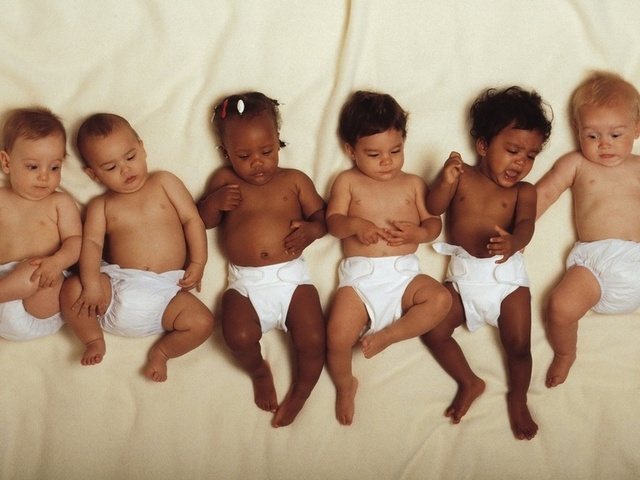
Children of different nations
One of the brightest and most long-awaited events for parents is the first independent sounds uttered by the child. Joyful sensations are often accompanied by worries, because children's croaking can stop as quickly and unexpectedly as it appeared. There may be several reasons for this kind of boycott. If a child stops gurgling at 4 months, this event should not be ignored. In most cases, this is the norm in speech development, but sometimes silence is a sign of physiological and emotional abnormalities.
The ability to coo - about the importance of the skill in the development of a child. Speech develops from simple to complex. Cooing is one of the types of speech activity that children master at 3–4 months.
The first training in sound production occurs voluntarily. At 2–3 months, this process is poorly developed and the baby can only pronounce vowels. This becomes a favorite pastime; no conscious control of sound chains is observed at this age.
Active, conscious and emotionally charged cooing is noted at 4 months of age. Sounds become a way to communicate with adults and favorite toys. During this period, the ability to control the muscles of the palate is formed. The baby masters the first consonants “g” and “x”, and in combination with vowels, the traditional and long-awaited “Agu” for parents is built.
The set of pronounced sounds is always individual and there can be any number of combinations. Don't worry if your baby's babbling is not similar to his usual cooing, and he makes fewer sounds than his peers. Enjoy another small victory and be attentive to any changes during this period.
A child does not coo at 4 months - is it worth worrying? Children in a good mood coo often and very emotionally. At four months they are already actively moving and laughing loudly. When the diapers are dry, the baby is fed, healthy, and his mother is nearby, he communicates with pleasure in the language of sounds familiar to him. But if the baby, in comfortable conditions for him, suddenly becomes silent, stops cooing, simply hums or squeals, watch him for several days. The reason for such sudden silence may be psychological problems. Children also experience stress. Any negativity in the family affects speech development. Lack of attention can provoke silence. If parents are always busy and spend little time with their child, he may respond with silence. There are also physiological factors:
Immaturity of the speech apparatus. Hearing problems. Underdevelopment of facial muscles. Neurological disorders. Consequences of past illnesses. To rule out the possibility of abnormalities and put your mind at ease, visit your pediatrician. Specialists will help identify and promptly eliminate health problems.
There are often cases when a child does not coo at 4 months and does not even try to pronounce new sounds. This behavior should also be cause for concern. As for the unusual and unexpected silence of the baby for the parents, according to pediatricians, such a change is considered one of the normal variants. This is just a preparatory stage for mastering new speech skills. Children always do what they like and enjoy. At some point, they get bored just yapping. The baby begins to understand that sounds can attract attention and curiously explores new vocal possibilities: squealing, clicking the tongue, mooing, loud laughter, etc. In addition, at this age, children actively watch adults. They pay attention, listen to what their parents say, absorb information, facial expressions and movements. They simply have no time to be distracted by cooing in the process of detailed study of the people and space around them.
How is cooing different from humming?
When does a child begin to hold his head up?
The roar of a child, no matter how many months it appears, undoubtedly pleases all family members. Based on the very name of the process of pronouncing sounds, you can understand how one differs from the other. When a child begins to coo, adults hear mainly vowel sounds. The most common of them are “a”, “y”, “and”. The child begins to pronounce them separately. Later, the baby will come up with a sequence of vowels similar to the well-known children's “agu.” He can start cooing as early as one month of age. This is especially common in children who are not deprived of communication with relatives.
Humming is a more complex set of sounds that smoothly develops into babbling. It already contains more consonant sounds, which, when combined with vowels, make speech richer and more interesting. Among the new letters, the most common are “b”, “g”, “c”, “d”. Pediatricians do not particularly monitor the ability to coo, but they will definitely ask about how often a child roars at the next appointment at the age of 2 months. This is the time when a properly developing baby demonstrates the start of mastering the speech apparatus.

Baby at the pediatrician's appointment
The appearance of consonant sounds in a child’s speech pleases him. Children are often delighted to realize that they are producing syllables that are similar to adult speech. Many kids entertain themselves in this way, repeating the same syllable they like several times, and even laugh at the same time.
What to do if the child does not coo
It happens that the baby suddenly stops gurgling. Don't worry. The reasons for this may be not feeling well or the need to take a time out to absorb new information.
If a baby is not cooing at 2 months, give him time. The development of children, including the development of speech, does not occur according to a schedule, but for each in its own way, often spasmodically, with pauses and even small rollbacks. An alarmed mother should not frantically search for an answer to the question: “At how many months does a child begin to coo?”, but rather help the baby a little.
And here's how:
- knead your baby’s palms very gently and affectionately to stimulate those areas of the brain that are responsible for speech function;
- talk to him, voice all your actions, answer him, add new sounds, in a word, communicate.
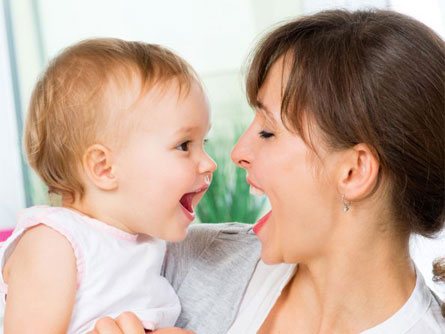
In this way, you can help the baby begin to speak and say the first “aha.”
What does a newborn react to with a smile?
When a child says "mama"
The first conscious smile may appear in a child in the first 5-6 weeks of life. She will certainly be a response to the communication of a close relative with him; most often the baby gives his first smile to his mother. After all, she is the one who spends the most time with him. Lying on his back, the child examines everything that comes into his field of vision.

First smile
Young parents should keep in mind that children in the first months of life are very nearsighted; their organ of vision is just beginning to develop. Most often, he can get a good look at his mother’s face. The child knows him better than anyone, and when she talks to him or plays with faces, the first smile appears, indicating that the baby receives positive emotions from such communication. The whole family, when their newborn begins to smile and walk, understands that development is in accordance with average statistical standards.
How to encourage your baby to talk
Every parent faces a serious task - to teach their child to communicate using human speech. Walking is an important stage in the development and formation of conversational skills. Of course, you won’t be able to force a child to coo, but why not encourage him to communicate?
How to teach a child to coo?
- Constant conversations. You should talk to your baby from birth - comment on actions, talk about your feelings, share your experiences. It doesn’t matter what exactly will be discussed. As a result of such conversations, children become familiar with different emotional colors, and the more there are, the better.
- Imitation. All children are known “repeaters” who, at any age, watch their parents and repeat their actions. When talking to a baby, you should use this. When a child begins to babble, you can repeat sounds after him, inviting him to dialogue, then gradually include new ones in the conversation.
- Palm massage. Finger games and massaging the palms promote the development of hand motor skills, which are closely related to children’s speech abilities.
An excellent solution for developing a child’s speech is folk art, which has a characteristic melodious quality. How many jokes, poems and songs have we known since childhood? All of them perfectly play up the cooing and encourage the baby to babble along with his mother.
Folklore is easy for children to understand, which is why children at any age are happy to pick up games such as: “Okay, okay, where have you been? By Grandma!" or “Geese, geese! Ha-ha-ha! Do you want to eat? Yes Yes Yes!". Just a couple of months will pass, and the baby will begin to recognize his favorite jokes, singing along to the delight of mom and dad.
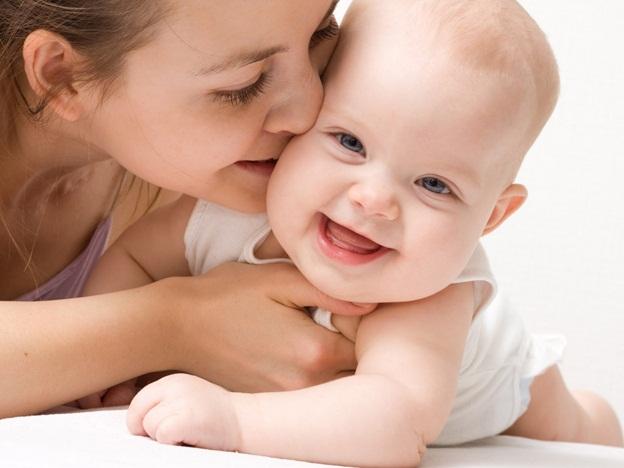
Methods for encouraging a child to “talk”
If a child has already begun to gurgle, his speech cannot be ignored. In addition to his emotional admiration, it is important for the baby to demonstrate his answers, thereby creating the first dialogues. When newborns begin to coo, they need to respond with similar syllables. Hearing his sound in response from his mother, he will be very happy, realizing his first sound contact.
Important! If adults repeat after the baby, he will begin to talk more actively, pronounce more clearly and call for conversation louder.
How to teach a child to say aha
Children who do not have serious congenital developmental anomalies say their first “aha” themselves; there is no need to teach them this. Medical research claims that those children with whom adults communicate a lot begin to coo earlier than others. The leisurely, clear speech of adults encourages the child to imitate. In this connection, in addition to regular screaming, calm, meaningful sounds appear.
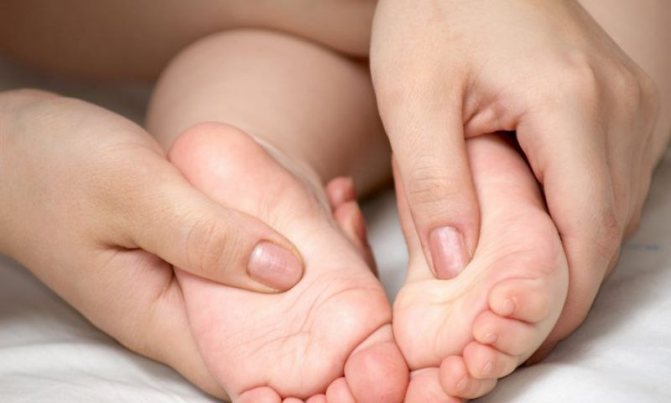
Foot massage
To stimulate the development of speech skills, pediatricians, including E.O. Komarovsky, recommend massaging the feet and palms, thereby activating large areas of nerve endings:
- Place the thumb of your hand in the baby's palm, allowing him to grab onto it.
- Feel the joints connecting the fingers to the hand and gently knead them in a circular motion.
- Knead each finger with rubbing movements from the base to the nail. For a more comfortable procedure, you can use baby cream. Apply a small amount of it to your fingers, increasing their glide, and then carefully feel each child’s finger, as if rubbing the cream.
- Lubricate your feet with baby cream. Perform circular rotations: from the heel to the pads under the toes.
- If you lightly press on the area of the pads, at the base of the toes, the baby will reflexively squeeze the toes.
- It is also important to massage each finger, paying special attention to the joints.
Attention! Regular massage will not only ease and bring closer the moment when the child begins to gurgle and coo, but also cope with muscle hypertonicity, if present.
When talking to a child, it is important to adhere to the basic rule - do not pronounce words too quickly. In order for speech to develop gradually in the future, without jumps and hesitations, parents should choose an average rate of pronunciation in the family. Sentences should be short but concise. This will make it easier for the baby to remember the meaning of what was said. Each action must be accompanied by the same phrases describing the event. Over time, the child will learn the meaning of words and respond to adult speech.
If the baby doesn't gurgle
The main question is how to teach a child to coo if he has not started doing it on his own. In medical practice, there are sufficient cases when a child, even three months old, has not yet begun to walk. The problem does not always lie in physiological developmental abnormalities. The more often adults communicate with the baby, the faster he will try to answer. Mom's songs are very useful. Humming is important not only before bed. If a child is upset and crying not because he is hungry or hot, but because he wanted a hug, even when they went out for a walk with him, it is better to calm him down not with rocking, but with singing.
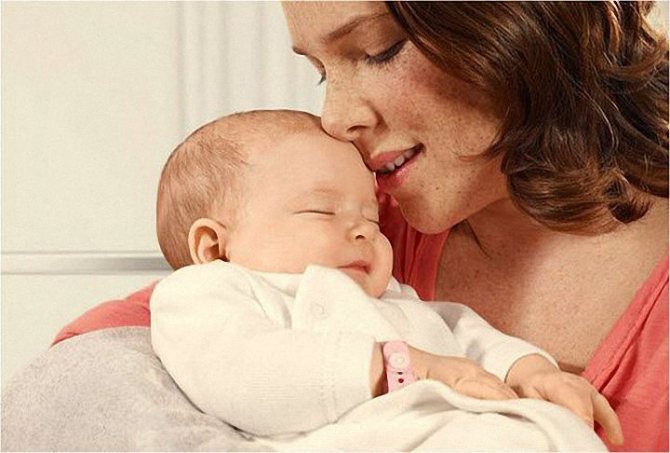
Mom sings to baby
The melodic intonation of the mother, accompanied by stroking the back, calms the baby much better than the shaking movements that parents are so drawn to. At the same time, the quieter the song, the more diligently the child will listen to it, forgetting about the whims. The mother's song will soon become recognizable to the baby, and he will try to reproduce it on his own.
Attention! The development of a child’s speech directly depends on the frequency of communication with him by his older relatives. In order to begin to pronounce sounds, the child must see how others do it.
It doesn’t matter what exactly his mother will tell him. The meaning of what was said at this stage of development does not matter. The main thing is intonation and articulation. You can write out loud, looking at the baby, a shopping list that will later be handed over to dad. You can “consult” with a child at this age by asking him questions and answering them yourself. Only the live daily speech of loved ones can push the baby to talk. A child should see how adults speak. The main ability of children is imitation. If the baby often sees how his relatives pronounce syllables and how their lips move, he will quickly begin to make attempts to repeat.
If a child does not try to make a sound for several months, the local pediatrician should be told about this. The doctor, knowing the characteristics of the child’s development, will be able to conclude whether additional examination by a neurologist is needed, or whether the parents simply need to devote more time to the baby.
Important! A constantly playing TV in the room irritates the child’s nervous system, while he is not able to concentrate on his mother’s communication. In order for a child to successfully develop his speech, it is necessary to protect him as much as possible from information garbage coming from a loud and bright screen.
Even the first conscious smile can be seen by deliberately smiling widely at the child. The more you exaggerate it, the sooner the baby will try to repeat it. Throughout the development of speech and other skills, the child will look to family members as role models. Therefore, it is important to remember that every day the family creates an individual. Not only prohibitions and rules need to explain in the future what is good and what is bad. Personal example is the best motivator in moving towards a goal.
Let's learn to coo together
In order for a child to begin to pronounce sounds earlier, you need to work with him daily, starting from 1.5 months of age.
- Talk to your baby. The child said “aha” when he saw you - smile at him, reciprocate, thereby attracting his interest and encouraging him to further communicate. From the first days of life, a child feels a connection with his mother, and therefore any contact with her has a positive effect on the improvement of his speech. When communicating with your child, talk through all the details: what toy you are holding, what the weather is like outside, what kind of porridge you are preparing for lunch. The baby may not understand you, but the very fact of communication is important for him - he picks up intonation, sounds and remembers them in order to try to reproduce them himself in the future.
- Repeat after your child everything he babbles. But between his “words”, try to insert your own. This way the baby will remember all the sounds faster and will begin to imitate you with great desire.
- Speak to the baby affectionately and playfully , but pronounce each word correctly, without distorting it - “lisping” harms the formation of correct speech.
- Develop your child's facial muscles , which take an active part in producing beautiful speech. Sit opposite the baby and pronounce the syllables, actively working with your facial muscles: stretch your lips like a tube, pull them in a smile almost “to the ears”, depict how a lion roars, how bunnies eat, how a cow moos, and how a horse laughs. It will not only be entertaining, but also instructive for your baby to repeat all your movements.
- Carry out creative activities with your child that promote speech development. For example, with the development of fine motor skills of the hands, a process takes place in the cerebral cortex that is responsible for the ability to correctly express words in the future. Buy finger paints that develop similar games, massage the inside of the baby’s palms - this is an important part of the initiation of the process when the child begins to coo.
- Teach your baby to sing. When developing speech, children first “work” on vowel syllables, which are the easiest to hum. You only need to show your child once how, for example, the mouth opens wide when pronouncing the syllable “a” or the lips stretch out funny when the sound “u” is heard, and the baby will remember and begin to repeat after you, humming to the beat. Such an activity will not only bring peace, but will also help work the child’s facial muscles.
- The feeling of complete and boundless maternal love will help shape children's speech. When communicating with the baby, do not forget to smile and stroke him, kiss him on the cheeks and nose, and gently press him to you. With such expressions of emotions, you give the baby comfort and the development of bright babble.
Why does a baby stop crying at 4 months?
One of the brightest and most long-awaited events for parents is the first independent sounds uttered by the child. Joyful sensations are often accompanied by worries, because children's croaking can stop as quickly and unexpectedly as it appeared. There may be several reasons for this kind of boycott. If a child stops gurgling at 4 months, this event should not be ignored. In most cases, this is the norm in speech development, but sometimes silence is a sign of physiological and emotional abnormalities. The ability to coo - about the importance of the skill in the development of a child. Speech develops from simple to complex. Gurgling is one of the types of speech activity that children master at 3–4 months. The first training in sound production occurs voluntarily. At 2–3 months, this process is poorly developed and the baby can only pronounce vowels. This becomes a favorite pastime; no conscious control of sound chains is observed at this age.
Active, conscious and emotionally charged cooing is noted at 4 months of age. Sounds become a way to communicate with adults and favorite toys. During this period, the ability to control the muscles of the palate is formed. The baby masters the first consonants “g” and “x”, and in combination with vowels, the traditional and long-awaited “Agu” for parents is built.
The set of pronounced sounds is always individual and there can be any number of combinations. Don't worry if your baby's babbling is not similar to his usual cooing, and he makes fewer sounds than his peers. Enjoy another small victory and be attentive to any changes during this period.
A child does not coo at 4 months - is it worth worrying? Children in a good mood coo often and very emotionally. At four months they are already actively moving and laughing loudly. When the diapers are dry, the baby is fed, healthy, and his mother is nearby, he communicates with pleasure in the language of sounds familiar to him. But if the baby, in comfortable conditions for him, suddenly becomes silent, stops cooing, simply hums or squeals, watch him for several days. The reason for such sudden silence may be psychological problems. Children also experience stress. Any negativity in the family affects speech development. Lack of attention can provoke silence. If parents are always busy and spend little time with their child, he may respond with silence. There are also physiological factors:
Immaturity of the speech apparatus. Hearing problems. Underdevelopment of facial muscles. Neurological disorders.
Consequences of past illnesses. To rule out the possibility of abnormalities and put your mind at ease, visit your pediatrician. Specialists will help identify and promptly eliminate health problems. There are often cases when a child does not coo at 4 months and does not even try to pronounce new sounds. This behavior should also be cause for concern. As for the unusual and unexpected silence of the baby for the parents, according to pediatricians, such a change is considered one of the normal variants. This is just a preparatory stage for mastering new speech skills. Children always do what they like and enjoy. At some point, they get bored just yapping. The baby begins to understand that sounds can attract attention and curiously explores new vocal possibilities: squealing, clicking the tongue, mooing, loud laughter, etc. In addition, at this age, children actively watch adults. They pay attention, listen to what their parents say, absorb information, facial expressions and movements. They simply have no time to be distracted by cooing in the process of detailed study of the people and space around them.

